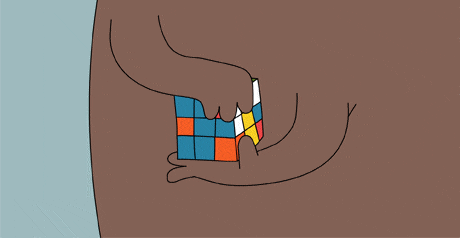Happy 40th anniversary Rubik's Cube!
 Today the Rubik's cube celebrates
years of bringing joy to children and adults alike.Besides the pleasure of solving it,it also has a lot of mathematics to it too.
Today the Rubik's cube celebrates
years of bringing joy to children and adults alike.Besides the pleasure of solving it,it also has a lot of mathematics to it too.
Consider a solved Rubik's cube. The six faces of the cube are named , , , , and respectively. An elementary move of the Rubik's cube is rotating a face by clockwise or anticlockwise. Any valid state of the Rubik's cube can be reached by applying these elementary operations one after the other.
An elementary move is denoted in the following fashion. If a given face is rotated by clockwise about the axis passing from the center of the face to the center of the cube, the move is denoted by the first letter of the name of the face. If the rotation is anticlockwise by , the letter is followed by an apostrophe (').These are all the elementary moves:
Given a single string of elementary moves let denote the number of times the sequence should be applied repeatedly to the solved cube to get back the original cube.
Consider the following ten strings
Find for the ten strings above.
Explicit examples
The answer is 1151.
This section requires Javascript.
You are seeing this because something didn't load right. We suggest you, (a) try
refreshing the page, (b) enabling javascript if it is disabled on your browser and,
finally, (c)
loading the
non-javascript version of this page
. We're sorry about the hassle.
I was inspired to make this problem because me and a friend had coded a Rubik's cube solver program a while back. I had the cube implementation lying around for a while. It was made using object oriented programming. We have many versions, this one is long but it is the most readable.